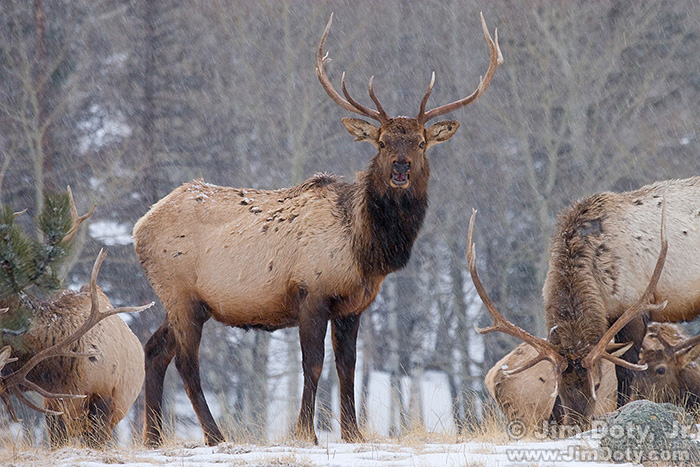Metering dark toned wildlife in the snow is a major exposure challenge. It is usually best to avoid large “burned out” areas (washed out, featureless white) in a nature or landscape photograph, but with properly exposed snow, the wildlife can be so dark as to lose all texture. On other hand, metering for the wildlife can burn out the snow.
Deciding which way to bias the meter reading depends a lot on how big the wildlife are in the frame. If the photo is mostly a landscape with the wildlife as a smaller element in the scene, you should bias the exposure for the snow and let the wildlife go dark, even if they lose texture. The wildlife are just another element in the scene, like trees and rocks. Meter the brightest area of the snow and use exposure compensation to make the snow light and bright without burning it out. The Metering Snowy Winter Scenes article will show you how.
On the other hand, if you are doing a closeup of one or more animals, you should meter the wildlife so they aren’t too dark, even if you burn out some of the surrounding snow. In this case the wildlife are primary and the snow is just a backdrop.
Sunlight is a major nemesis when photographing dark wildlife in white snow. The sunlight increases the contrast level well beyond thee ability of a camera sensor to record without losing the highlights and/or the shadows.
On a light but overcast day (like the photo above), the contrast is tamed so it is much easier to get a good exposure for the wildlife without burning out the snow. This is much better light for dark wildlife in the snow. It is important to leave out the sky on a day like this since the sky will be burned out.
How do you meter for the photo above? If your camera has a spot meter, you can meter the side of the elk and make that a medium tone (no exposure compensation), or better yet add between 1/3 to 2/3 stops of plus exposure compensation (+1/3, +1/2, +2/3) to make the side of the elk is a little lighter than a medium tone so you can maintain texture in the darker fur on the head, neck, and legs. You can learn more about exposure compensation in this article on Using Reflected Light Meters.
If your camera doesn’t have a spot meter, the camera meter will see enough of the larger scene to make metering less reliable. The simple solution is to meter a gray card in the same light as the elk (which is easy in this case since the light on the overcast day is the same everywhere except for back in the trees) and use that as your base exposure. I would suggest adding about 1/3 to 1/2 stops of plus exposure compensation (+1/3, +1/2) to the result you get from metering the gray card to insure a better exposure for the darker areas of the elk.
The angle of the gray card is important. You are exposing for the side of the elk, not the top, so don’t point the flat surface of the gray card up at the sky when you meter it. Hold the gray card so it is more or less parallel to the side of the elk, with maybe a slight upward angle, very much like the side of a steep pyramid, or the sides of the Transamerica Pyramid building in San Francisco. You can learn more by reading How to Use a Gray Card.
Photo Data: Canon 20D. Canon 100-400mm lens at 285mm (a full frame equivalent of 456mm). f/8, 1/50 sec, ISO 400.
Links
Why Is Exposure So Important? The first in a series series of articles covering the basics of exposure with links to the rest of the series.
Mastering exposure is one of the first and most important steps to becoming a better photographer. One of the best ways to do this is to read Digital Photography Exposure for Dummies and do the exposure exercises in the book. This book will teach the the basics and then take you well beyond the basics. It has a five star rating at Amazon.com and is praised by amateurs and professionals alike as one of the most helpful and comprehensive books on exposure currently available. You can learn more here and order it at Amazon.com.
The best guide books for finding wildlife.
Great “How To” Nature Photography Books (including the excellent Stackpole series of books on photographing wildlife)..
Rocky Mountain National Park – the official web site. RMNP is one of my favorite places to photograph elk in the fall when they gather in open areas of the park for thr rut. Make the rounds between Moraine Park, Upper Beaver Meadows, and Horseshoe Park (where the above photo was taken).

